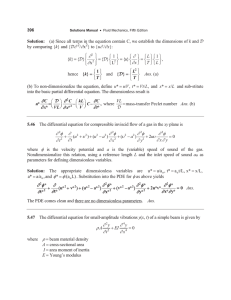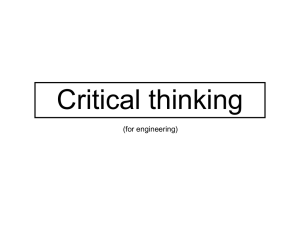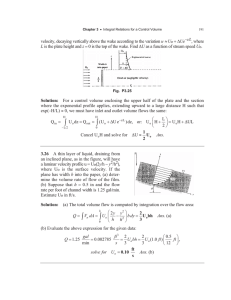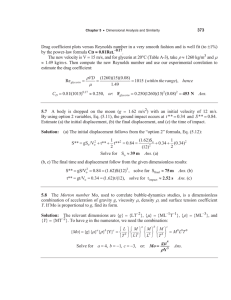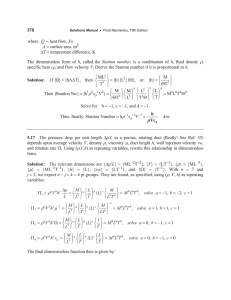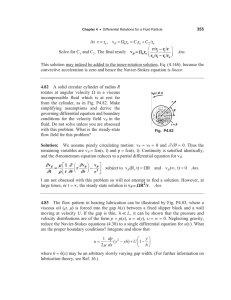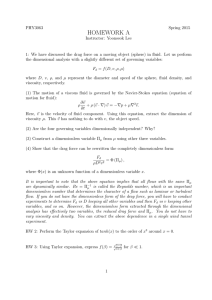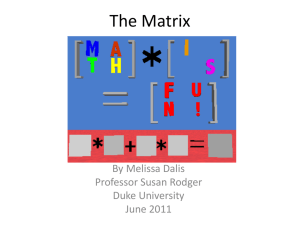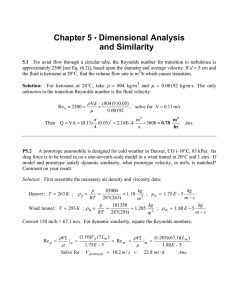w
advertisement
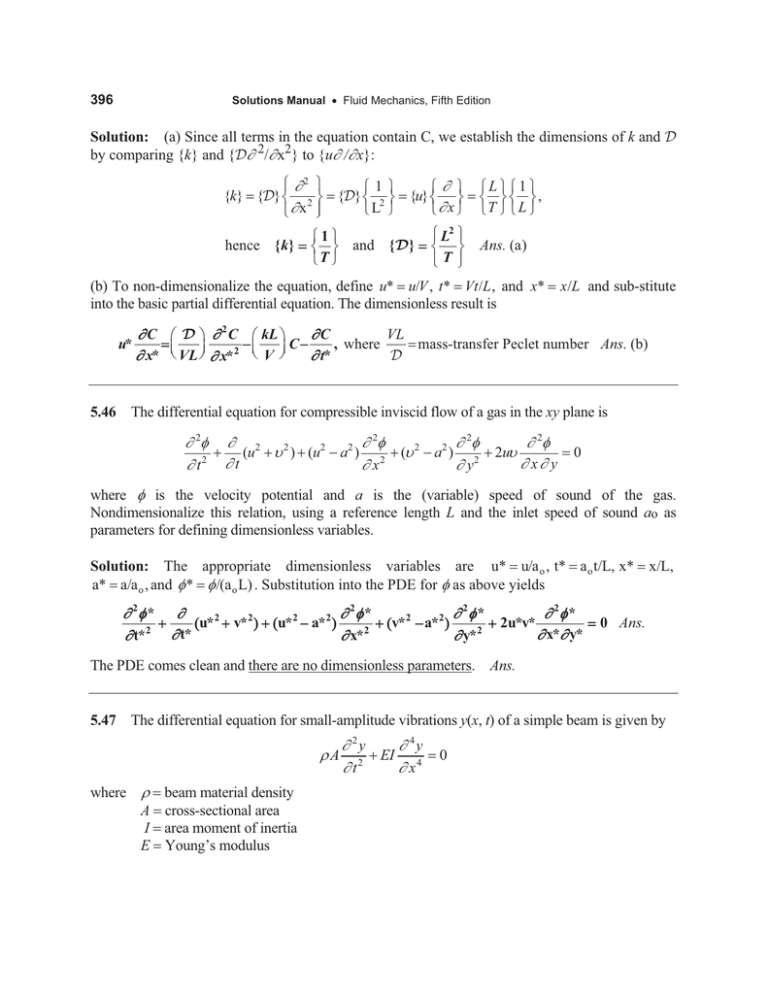
396
Solutions Manual x Fluid Mechanics, Fifth Edition
Solution: (a) Since all terms in the equation contain C, we establish the dimensions of k and by comparing {k} and {w2/w x2} to {uw/w x}:
­ w2 ½
­1½
­w ½
{k} {} ® 2 ¾ {} ® 2 ¾ {u} ® ¾
¯L ¿
¯w x ¿
¯ w x °¿
hence { k}
­1½
® ¾ and { }
¯T ¿
­L ½­ 1 ½
® ¾ ® ¾,
¯T ¿ ¯ L ¿
­ L2 ½
® ¾ Ans. (a)
¯ T °¿
(b) To non-dimensionalize the equation, define u* u/V , t* Vt /L , and x*
into the basic partial differential equation. The dimensionless result is
u*
x/L and sub-stitute
w C § · w 2 C § kL ·
wC
VL
C
, where
mass-transfer Peclet number Ans. (b)
¨©
¸¹
¸
2 ¨
w x* VL w x* © V ¹
w t*
5.46 The differential equation for compressible inviscid flow of a gas in the xy plane is
2
2
w 2I w 2 2
w 2I
2
2 w I
2
2 w I
(u X ) (u a ) 2 (X a ) 2 2uX
w xw y
w t2 w t
wx
wy
0
where I is the velocity potential and a is the (variable) speed of sound of the gas.
Nondimensionalize this relation, using a reference length L and the inlet speed of sound ao as
parameters for defining dimensionless variables.
Solution: The appropriate dimensionless variables are u* u/a o , t* a o t/L, x* x/L,
a* a/a o , and I * I /(a o L) . Substitution into the PDE for I as above yields
2
2
w 2I * w
w 2I *
2
2
2
2 w I*
2
2 w I*
u* v* u* a* v* a* 2u*v*
w x*w y*
w t*2 w t*
w x*2
w y*2
0 Ans.
The PDE comes clean and there are no dimensionless parameters. Ans.
5.47 The differential equation for small-amplitude vibrations y(x, t) of a simple beam is given by
UA
where U
A
I
E
beam material density
cross-sectional area
area moment of inertia
Young’s modulus
w 2y
w 4y
EI
w t2
w x4
0
397
Chapter 5 x Dimensional Analysis and Similarity
Use only the quantities U, E, and A to nondimensionalize y, x, and t, and rewrite the differential
equation in dimensionless form. Do any parameters remain? Could they be removed by further
manipulation of the variables?
Solution: The appropriate dimensionless variables are
y
y*
A
; t* t
E
; x*
UA
x
A
Substitution into the PDE above yields a dimensionless equation with one parameter:
w 2 y* § I · w 4 y*
¨
¸
w t*2 © A 2 ¹ w x *4
0; One geometric parameter:
We could remove (I/A2) completely by redefining x*
I
A2
Ans.
x/I1/4 . Ans.
5.48 A smooth steel (SG 7.86) sphere is immersed in a stream of ethanol at 20qC moving at 1.5
m/s. Estimate its drag in N from Fig. 5.3a. What stream velocity would quadruple its drag? Take D
2.5 cm.
Solution: For ethanol at 20qC, take U | 789 kg/m3 and P | 0.0012 kg/ms. Then
ReD
U UD
P
789(1.5)(0.025)
| 24700; Read Fig. 5.3(a): CD,sphere | 0.4
0.0012
Compute drag F
S
§1·
CD ¨ ¸ U U 2 D2
4
©2¹
| 0.17 N Ans.
§1·
§S ·
(0.4) ¨ ¸ (789)(1.5)2 ¨ ¸ (0.025)2
©2¹
©4¹
Since CD | constant in this range of ReD, doubling U quadruples the drag. Ans.
5.49 The sphere in Prob. 5.48 is dropped in gasoline at 20qC. Ignoring its acceleration phase, what
will its terminal (constant) fall velocity be, from Fig. 5.3a?
Solution: For gasoline at 20qC, take U | 680 kg/m3 and P | 2.92E4 kg/ms. For steel take U |
7800 kg/m3. Then, in “terminal” velocity, the net weight equals the drag force:
( Usteel U gasoline )g
Net weight
or: (7800 680)(9.81)
S
6
(0.025)3
S
6
0.571 N
D3
Drag force,
S
§1·
CD ¨ ¸ (680)U 2 (0.025)2
4
©2¹
